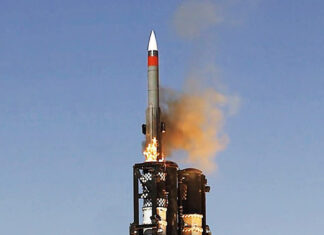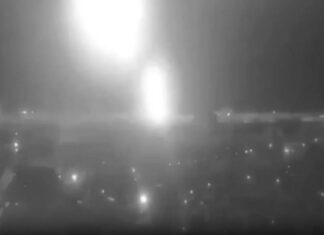
Following military pressure mounting with a third night of attack by the coalition, forces loyal to Muammar Gaddafi were reported withdrawing from Benghazi. Shifting their pressure to the west on Tuesday, Gaddafi’s forces attacked two Libyan towns on the eastern border with Tunisia. Realizing that air strikes are not limited to air defense, but are now targeting mechanized formations near rebel concentrations, Libyan forces have taken alternative means of action, utilizing ‘urban guerilla’ type activities, by employing small dismounted formations and snipers to take out rebel targets. Overall, despite the chaos raging in the recent month, Libyan loyal forces seem to be relatively organized and under control, while anti-Gaddafi rebels still struggle accepting an agreement on a command structure that will be able to capitalize on the support by coalition air strikes, as long as it will last.

Yesterday, coalition air forces have suffered their first loss, as an F-15E crashed in Libya. Both crewmen have ejected and ‘are safe’, a U.S. Air Force statement said. News reports claim the two crewmen were picked up by rebel forces. The incident happened over Libya on 10:30 p.m. as both crewmen ejected after the aircraft ‘experienced equipment malfunction over northeast Libya, the Air Force said. The aircraft, based out of Royal Air Force Lakenheath, England, was flying out of Aviano Air Base in support of Operation ‘Odyssey Dawn’ at the time of the incident.

While the U.S. has so far paid most of the bill, spending the majority of ordnance used, France and Britain have yet to agree on who will lead the operations, as Washington plans to pull back to a supporting role. The U.K. has recommended control should be transferred to NATO but France is objecting such move raising concern over Arab sensitivity of European military power being involved in Middle Eastern affairs. Since operation Odyssey-Dawn began, U.S. Army General Carter F. Ham, Commander, U.S. Africa Command is leading the coalition enforcement of the No Fly Zone over Libya. Ham is expected to transition command to one of his European piers in the coming days. “This is a very complex task under the best of conditions,” Han commented, “my goal is to not cause disruptions to the on-going operation while we effect the headquarters transition.”
“The number of countries conducting military operations enforcing the UN resolution continues to grow. US, French, Danish, Italian and British aircraft were yesterday joined on patrol over Libya by Spanish F-18s for the first time. So far this joint operation remains under US command, but this could change, said Major General John Lorimer, the Chief of the Defence Staff’s Strategic Communications Officer.

Lacking an aircraft carrier in the area, Coalition forces depended on long-range strikes and cruise missile attacks to gain the initial effect. The U.S. Navy offered the most dominant firepower, supporting the initial attack with Tomahawk cruise missiles while the Air Force’s B-2 Spirits bombers followed with precision strikes against Libyan airfields and air defenses. F-15E Strike Eagles and F-16CJ Fighting Falcons flying from bases in Northern Italy covered these missions. Their primary goal was to eliminate the risk from the Libyan integrated air defense systems, a network of radars, surface-to-air missiles in fixed and mobile sites connected through a command and control system. Although considered a potent threat to an average opponent, the Russian-origin air defenses were no match for the U.S. forces, which have already demonstrated their capability in dealing with modern air defenses in the past.
“We judge these strikes to have been very effective” director of the Joint Staff, Vice Admiral Bill Gortney said in a press briefing in the Pentagon. Directed at the Libyan air defense command and control nodes at known sites, the initial attack has ‘significantly degraded’ Libyan air defense capability in launching their SA5s, SA3s and the SA2s, Gortney said. By the next day (March 20) all Libyan radars were silent. “We detected no radar emission from any of the air defense sites targeted, and there has been a significant decrease in the use of all Libyan air surveillance radars, most of those appear to be limited now only to the areas around Tripoli and Sirte” Gortney added.
While the fixed air defense sites are neutralized, mobile surface-to-air missiles (SA-6, SA-8, SA-24 and many SA-7 type MANPADS) remain operational. As some of these use passive sensors (TV/IR), they do not rely on radar for operation and, therefore, coalition forces cannot pre-empt their attack, but only use self-defense measures (flares, deception etc.) Electronic attack aircraft (E/F-18G Growler) are available to deal with the radar guided sites. This threat is likely to prevent coalition air forces from flying low level missions, and could also restrict the operation of aerial gunships, attack helicopters and casualty evacuation missions in theater.
Among the B-2s targets was the Libyan Air Force base in Ghardabiya, where Libyan fighter aircraft were believed to be parked in hardened shelters. Some 90 shelters were located on this base, each accommodating a single fighter plane (most likely Su-22 or MiG-23/27). Three B-2 Spirit stealth bombers, flying from the Whitman U.S. Air Force in Montana, targeted these shelters with JDAM GPS guided concrete penetration bombs. Many shelters were hit and partly destroyed.
On the opening strike Coalition forces launched 118 Tomahawk and Storm Shadow cruise missiles, targeting air defense and airfields throughout Libya. In total, Coalition forces launched 124 Tomahawk cruise missiles at Libyan air defenses, command and control nodes, a Scud missile site and an air defense site.

Enforcing the no-fly zone is also making progress, but coalition aircrews still confront dangerous environment, especially with low-level attacks. Despite France and the U.K. gaining high profile for their operations, the U.S. forces are bearing the majority of the work load. Yesterday, about 50 per cent of the missions were flown by U.S. forces with the remaining flown by France, U.K and other coalition partners. Among the U.S. units operating over Libya, F-15E deployed from RAF Lakenheath in the U.K to Aviano air base in Northern Italy, where U.S. Air Force F-16CJs are permamently based. These Falcons were also taking part in the recent combat operations. Others aircraft are supporting combat missions, include EC-135 Rivet Joint electronic intelligence plane, EC-130H Compass Call electronic attack platform, EC-130J Commando Solo psychological warfare platform, KC-135 aerial refueling aircraft and E-3C Airborne Warning & Control (AWACS).
Overall, the Libyan Air Force ceased operations since the ‘No Fly Zone’ regime was declared by the U.N. “I assess that our actions to-date are generally achieving the intended objectives,” Army Gen. Carter F. Ham, said. “We have not observed Libyan military aircraft operating since the beginning of coalition operations.” General Ham said.
Naval air power stationed off the Libyan coast has now been deployed and is expected to increase the European partners’ operational tempo. The arrival of the French aircraft carrier Charles DeGaulle and the Italian carrier Garibaldi is introducing French Rafale F3 and Super Étendard strike fighters with the Italians operating AV-8Bs, used mostly for ground attack role.
As part of the Operation ELLAMY, the British contingent of the operation, the new RAF Typhoon fighters, deployed to Gioia del Colle in Italy on Sunday, mounted their first ever mission into hostile airspace, patrolling the no-fly zone under the control of an RAF Sentry AWACS aircraft and supported by an RAF VC10 tanker. Separately, a formation of Tornado GR4 aircraft again flew south from RAF Marham. Unlike their previous sorties on Saturday and Sunday, which were focused on Libyan military command and control facilities and air defense infrastructure, their mission yesterday was an armed reconnaissance sortie directly protecting the civilian population against attacks by Colonel Gaddafi’s ground forces. “With their state-of-the-art Litening targeting pods and a variety of precision-guided munitions, the Tornados are very well equipped to identify any emerging threats on the ground and deliver a dynamic and effective response” Major General Lorimer added. On completion of their mission, the Tornados joined the Typhoons at the forward based at Gioia del Colle. Both Tornado GR4 and Typhoons were supported by VC10 and TriStar tankers.
Flying ground attack missions against Libyan government forces is a complex and somewhat ‘fluid’ situation. It seems Coalition attacks depend on their perception of Libyan movements. “There is no intent to completely destroy the Libyan military forces, but concentrate our efforts against entirely threats against civilians, within the scope of the UNSC directives, warns General Ham. Describing a typical operational process involved: ” Taking a particular area, perhaps including some 50 or so km south of the rebel stronghold Bengazi, when we detect a group of vehicles, which we identify as Gaddafi loyalists, we refrain from attacking immediately, instead are watching their actions.” gen. Ham said if Libyan units continue moving away from the conflict area, the Coalition shall maintain observation mode only, letting them get out of the area, “if they are compliant with [the resolution], we shall not attack them” Ham said.



















